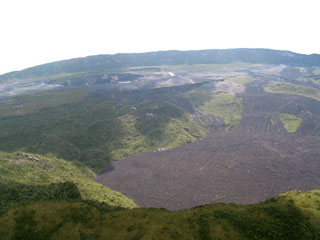Report on Nyamulagira (DR Congo) — May 2004
Bulletin of the Global Volcanism Network, vol. 29, no. 5 (May 2004)
Managing Editor: Richard Wunderman.
Nyamulagira (DR Congo) During 26 May-1 June observers noted weak eruptions and local ashfall
Please cite this report as:
Global Volcanism Program, 2004. Report on Nyamulagira (DR Congo) (Wunderman, R., ed.). Bulletin of the Global Volcanism Network, 29:5. Smithsonian Institution. https://doi.org/10.5479/si.GVP.BGVN200405-223020
Nyamulagira
DR Congo
1.408°S, 29.2°E; summit elev. 3058 m
All times are local (unless otherwise noted)
When last reported (BGVN 29:04), Nyamuragira was in the midst of an eruption that had begun on 8 May 2004 and continued through 12 May. The Toulouse Volcanic Ash Advisory Center (VAAC) reported that satellite imagery showed a weak ash eruption on 25 May and that from 26 May to 1 June there were weak but steady emissions from Nyamuragira and neighboring Nyiragongo (~13 km SE of Nyamuragira). The Goma volcano observatory confirmed that ash fell within a radius of 60 km of both volcanoes. VAAC reports on 1 June said that satellite imagery indicated the eruptions at Nyamuragira had ceased.
Geological Summary. Africa's most active volcano, Nyamulagira (also known as Nyamuragira), is a massive high-potassium basaltic shield about 25 km N of Lake Kivu and 13 km NNW of the steep-sided Nyiragongo volcano. The summit is truncated by a small 2 x 2.3 km caldera that has walls up to about 100 m high. Documented eruptions have occurred within the summit caldera, as well as from the numerous flank fissures and cinder cones. A lava lake in the summit crater, active since at least 1921, drained in 1938, at the time of a major flank eruption. Recent lava flows extend down the flanks more than 30 km from the summit as far as Lake Kivu; extensive lava flows from this volcano have covered 1,500 km2 of the western branch of the East African Rift.
Information Contacts: Baluku Bajope and Kasereka Mahinda, Observatoire Volcanologique de Goma, Departement de Geophysique, Centre de Recherche en Sciences Naturelles, Lwiro, D.S. Bukavu, DR Congo; Toulouse Volcanic Ash Advisory Center (VAAC), Météo-France, 42 Avenue Gaspard Coriolis, F-31057 Toulouse cedex, France (URL: http://www.meteo.fr/vaac/); TOMS Volcanic Emissions Group (URL: https://so2.gsfc.nasa.gov/).

